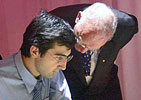


ChessBase 17 - Mega package - Edition 2024
It is the program of choice for anyone who loves the game and wants to know more about it. Start your personal success story with ChessBase and enjoy the game even more.

Veselin Topalov vs Vladimir Kramnik Twelve games, played from September 23 to October 12 in Elista, Kalmikia. The games start at 15:00h (3:00 p.m.) local Elista time, which translates to 11:00h GMT, 13:00h CEST, 12:00h London, 7 a.m. New York. |
 |
| Live coverage is available on the official FIDE site and on Playchess.com (with live audio commentary by GM Yasser Seirawan for ten Ducats per day). You can buy them in the ChessBase Shop. |

"I think you should tell them." Arbiters Panagiotis Nikolopoulos
and Geurt Gijssen

"Mr Kramnik, they found two dead flies in your rest room."

"Mr Topalov, the flies are being carefully checked by electronics experts"

"Okay, no microprocessors in the flies – Gentlemen, the game
can begin!"

Game ten under way, with Vladimir Kramnik playing white against Veselin
Topalov

Big Vlad Kramnik, the winner of game ten – photos by courtesy
of FIDE
The following express commentary was provided to us by Romanian GM Mihail Marin, who is the author of a number of very popular ChessBase training CDs and articles for ChessBase Magazine. GM Marin will study the game from the World Championship in Elista in greater detail and provide the results of his analysis in the next issue of ChessBase Magazine. Note that there is a replay link at the end of the game. Clicking this will produce a (separate) JavaScript replay window, where you have replay buttons but can also click on the notation to follow the moves.
Kramnik,V (2743) - Topalov,V (2813) [E08]
WCh Elista RUS (10), 08.10.2006 [Mihail Marin]
Topalov chose a solid variation but then went for a slightly risky experiment. Kramnik managed to find the weak spot in Black's whole concept and obtained a very pleasant position. After Topalov's blunder on the 24th move the game was practically over re-establising the equality in the match. 1.d4 Nf6 2.c4 e6 3.Nf3 d5 4.g3 Bb4+. Being ahead on the score table for the first time from the beginning of the match, Topalov refrains from capturing on c4 already. Instead, he adopts a hybrid between the Bogo-Indian and the Catalan, supposed to offer Black a solid position. Maybe not the best psychological approach... 5.Bd2 Be7 6.Bg2 0-0 7.0-0 c6 8.Bf4 Nbd7 9.Qc2 a5. The main variation is supposed to be 9...b6 10.Rd1 Ba6 11.b3 . By refraining from such a course of events, Topalov might have taken into account the fact that Kramnik likes to transpose to this position from the main variation of the Queen's Indian. The move played in the game refrains from weakening the c6-square yet, but does not really contribute to the development in any way. 10.Rd1 Nh5 11.Bc1.
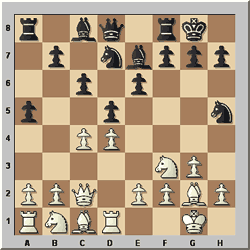
11...b5. Each of these last moves is typical for this variation, but only if taken seperately. Removing the knight from the centre and advancing the queen side pawns at the same time certainly looks risky. When preparing for the game, Topalov might have overlooked White's logical reaction. It should be said that 11...Nhf6 12.Nbd2 b5!? does not offer Black an easy game in view of 13.c5 Qe8 14.e4+/= Marin-Pogorelov, Barcelona 1994, an old game I like to speak about. 12.cxd5!?N White's standard reaction to ...b5 is 12.c5. However, in this concrete position Black could take advantage of the insertion of ...Nh5 by playing 12...f5 as in the only game where this risky plan was seen so far, Rahman-Ghaem, Doha 2003. Optically, White enjoys a more flexible structure but it is not too clear how and where will he be able to open the position. 12...cxd5 13.e4! The only logical continuation after the exchange on d5. Otherwise, Black would have a very comfortable position, because of the relative passivity of his Catalan bishop, severly restricted by the black chain of pawns. 13...dxe4 14.Qxe4+/=. Once the position has been opened, Black's delay in development starts making itself felt. Apart from having provoked considerable loss of time, the advance of the queen side pawns has left Black with several weaknesses. 14...Rb8. The only way to justify the move ...a5 would be the slightly more active development of the rook to a6, but after 14...Ra6 15.Qe2 the queen would target the h5-knight and the b5-pawn at the same time. 15.Qe2 Nhf6. Black's main trump consists of the control of the d5-square, which makes this willing knight retreat perfectly understandable. 16.Bf4 Rb6 17.Ne5 Nd5.
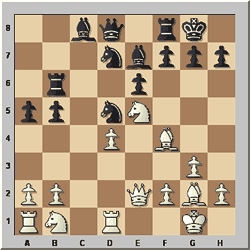
Black would need just one tempo to consolidate with ...N7f6 in order to get a perfectly viable position. 18.Bxd5! A brave decision. It frequently happens in the Catalan that White has to give up the pride of his position in order to maintain the initiative. 18...exd5 19.Nc3 Nf6 20.Nxb5 Ba6 21.a4. White has not only won a pawn, but also completed his development in the meanwhile. It is likely that Black will manage to re-establish the material equality by means of an exchange on b5 in the near future, but this would make the weakness of the white king side less relevant, leaving White with the more pleasant play in an almost symmetrical Position. 21...Ne4 22.Rdc1 Qe8 23.Rc7 Bd8 24.Ra7

24...f6?A terrible move. It is understandable that Topalov was not too enthusiastic about the position arising after 24...Bxb5 25.axb5 Qxb5 26.Qxb5 Rxb5 27.Ra2+/= when White would retain a small but stable plus, but his move loses outright. 25.Nd7! Even if Topalov had missed this move, it is not very clear what he had in mind against 25.Qg4!? which also looks very promissing for White. 25...Rf7 26.Nxb6 Rxa7 27.Nxd5. White has won a second pawn and threatens to consolidate by retreating the d5-knight to c3 and eventually close the long diagonal with d5 if Black tries to start an attack with ...Bb7. From this point of view, Topalov's nect moves are easy to understand, but in fact they just shorten his suffering. 27...Rd7 28.Ndc3 Rxd4 29.Re1. There seem to be nothing wrong with 29.f3 , when Black simply loses the knight because after 29...Nd6 30.Qxe8+ Nxe8 the b5-knight would be not pinned anymore, which enables 31.Nxd4+- . However, it is easy to understand Kramnik for avoiding such a "weakening" move as f3 after having lost two games in a row. Just remember the consequences of this same move in the seventh game... 29...f5. More or less forced, but now the a2-g8 diagonal becomes very weak. 30.Qc2 Simple chess. White is a pawn up, has the better piece coordination and the safer king's position. With other words, "+-" already. 30...Rb4 31.Nd5 Rxb5. Topalov carries out his "trademark" exchange sacrifice, which brought him so many successs over the past years. However, it can hardly change the course of this specific game. 32.axb5 Qxb5 33.Nc7 Qc4 34.Qd1. There was nothing wrong with exchanging queens at once, of course. By playing such an unexpected move (to a certain extent similar to the earlier Qc2) , Kramnik might have intended to get some sort of psychologic initiative for the remaining two games of the match. 34...Bxc7 35.Qd7 h6 36.Qxc7 Qb4 37.Qb8+ Qxb8 38.Bxb8. The rest is easy. 38...Nd2 39.Ra1 g5 40.f4 Nb3 41.Ra3 Bc4 42.Bc7 g4 43.Bxa5 1-0. [Click to replay]
 |
Mihail
Marin, 41, Romanian Grandmaster, three times national champion
(1988, 1994, 1999), nine times member of the Olympic team, participant
in two Interzonals (Szirak 1987 and Manila 1990). In 2005 Marin was
the second of Judit Polgar at the FIDE world championship in San Luis.
Highest rating: 2604. Author of the ChessBase opening CDs English
1.c4 e5 and The
Catalan Opening and the books: Secrets of Chess Defence,
Secrets of Attacking Chess and Learn from the Legends.
Graduate from the Polytechnic Institute Bucharest (Specialty Electrotechnic)
in 1989. |
Once again a new record for the number of visitors simultaneously logged into the Playchess server: 8741 at the end of the game.
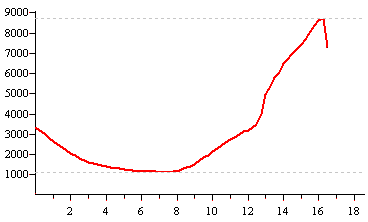
The live audio commentary by GM Yasser Seirawan during the games is a great success. Many hundreds of spectators attend. If you missed any of the shows, or if you want to see what they are like (before committing a little over a dollar for an entire afternoon) you can watch them offline in the Playchess Media room:
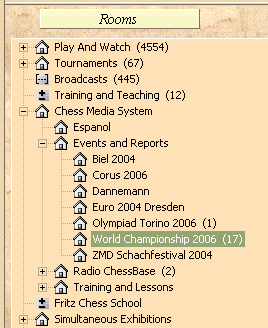
The videos are to be found in the room Chess Media System – Events and Reports – World Championship 2006. Double-click on this and then on the "Games" tab to get the contents:

Above is a small segment of the audio files that are available. Some are free, most cost two ducats (less than 30 cents) to watch.
| Player | |
|
|
|
|
|
|
|
|
|
|
|
|
|
|
| Veselin Topalov | |
|
|
|
|
||||||||||
| Vladimir Kramnik | |
|
|
|
|
|
| Schedule of the World Chess Championship 2006 | ||||
| Day 18 | Mon. | 9 Oct | Rest day | |
| Day 19 | Tues. | 10 Oct | 3:00 p.m | Game 11 |
| Day 20 | Wed. | 11 Oct | Rest day | |
| Day 21 | Thurs. | 12 Oct | 3:00 p.m. | Game 12 |
| Day 22 | Friday | 13 Oct | 3:00 p.m. | Tiebreaks, closing |